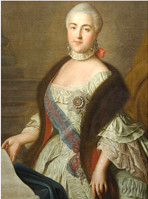
Catherine II the Great was born
21 April (2 May), 1729 in the German city of Stettin (now Szczecin, Poland) was born Sophie Auguste von Anhalt-Zerbst, the future Russian Empress Catherine II.
In 1744, on the invitation of Russian Empress Elisaveta Petrovna (Elizabeth of Russia), Sophia and her mother arrived to Russia. She converted to Orthodoxy and was baptized with the name of Catherine Alekseevna, and in 1745 married the Grand Duke Peter Fedorovich, the future Emperor Peter III. As soon as she arrived to Russia Catherine began to study Russian language, history, and Russian traditions. Later she turned to reading the works of French enlighteners, and works on philosophy, law and economics, becoming a supporter of the Enlightenment.
After accession to the throne of Peter III, Catherine's relationship with her husband continued to deteriorate. Because of the threat of arrest and possible expulsion Catherine decided to take part in the coup, supported by the Orlov brothers, graphs N. I. Panin and K. G. Razumovsky. On the night of June 28 (July 9), 1762 Catherine secretly arrived to St. Petersburg and in the barracks of Izmailovo Regiment was declared the autocratic empress.
In the early years of her reign Catherine II reformed the Senate (1763); secularized church lands (1764) which significantly enriched the state treasury and alleviated the plight of millions of peasants; eliminated hetmans in Ukraine in line with her views on the need to unify the governance throughout the empire; invited foreigners to Russia for the development of the Volga regions and Black Sea.
The Empress carried out important reforms in the military, social and financial spheres. In 1763, the Empress established the Naval Committee, which was granted extensive rights to carry out reforms in the Russian Navy. In September 1765 the government of Catherine II promulgated the "Manifesto on the Empire’s General Land Survey" that separated privately-owned lands one from another and from state-owned lands. In 1769 soft money (banknotes) was introduced in Russia.
In 1767 the Empress announced the convening of the Commission to compose a new Code, which included elected deputies from all social groups of the Russian society, with the exception of serfs. Catherine wrote the "Instructions" for the Commission, which became the liberal program of her reign.
In 1775 was issued a manifesto which allowed to freely establish any industry. The same year was made the Governorate reform, which introduced the new political division of the country. In 1782, the Empress created a new municipal administrative and police authority - Discipline (police) Department.
In 1785 Catherine II published well-known legislative acts - Charters for cities and nobility. For the Russian nobility Catherine document meant the legal consolidation of almost all rights and privileges available to the nobility, including exemption from compulsory public service. Charter for cities had set new elective municipal agencies, expanded the circle of voters and consolidated the basis of self-government.
In 1773, by decree of Catherine II in St Petersburg was founded Russia's first and second in the world higher technical educational institution - Mining School which trained specialists of metalworking industries. In 1781 was initiated the creation of a national system of public education in Russia - a network of urban school facilities was established. In the following years, the Empress also continued to develop plans for major reforms in education. In 1783 Catherine II issued a decree "On the arbitrary printers" that allowed individuals to engage in publishing activities. In 1795, Catherine the Great approved the project of construction of the first public library in St. Petersburg.
During her reign, the Russian Empress had won two wars against the Ottoman Turks (Russian-Turkish war of 1768-1774 and 1787-1791), which resulted in Russia’s stable position in the Black Sea. Leading the alliance with Austria and Prussia, Catherine participated in the three partitions of Poland. In 1795, the Empress issued a Manifesto on annexation of Courland "to the Russian Empire forever".
At the end of 1780s along with the Russian-Turkish war began the war with Sweden, which was trying to get revenge for its defeat in the Northern War. However, Russia has successfully coped with the two adversaries. In 1790 in the village of Verele (Vyaryalya) the peace treaty was signed, which ended the Russian-Swedish war. In 1792, the Jassy Treaty was concluded, which recognized the influence of Russia in Bessarabia and the Caucasus, as well as the annexation of Crimea.
The era of Catherine the Great was marked by the constellation of outstanding statesmen, generals, writers and artists. Among them a special place was occupied by Adjutant-General I. I. Shuvalov, Count P. A. Rumyantsev-Zadunaisky; Admiral V.Ya. Chichagov; Generalissimo A. V. Suvorov, Field Marshal G. A. Potemkin, educator, publisher N. I. Novikov, historian, archaeologist, artist, writer, collector, A. N. Olenin, president of the Russian Academy E. R. Dashkova.
The morning of 6 (17) November 1796 Catherine II died and was buried in the tomb of Peter and Paul Cathedral. 77 years after the death of Catherine in St. Petersburg on Alexandrinskaya Square (now Ostrowsky Square) was inaugurated the monument to the great Empress.
Lit.: Брикнер А. Г. История Екатерины II. СПб., 1885; Грот Я. К. Воспитание Екатерины II // Древняя и новая Россия. 1875. Т. 1. № 2. С. 110-125; Екатерина II. Её жизнь и сочинения: Сб. историко-литературных статей. М., 1910; Иоанна-Елизавета Ангальт-Цербстская. Известия, писанные княгиней Иоанной-Елизаветой Ангальт-Цербстской, матерью императрицы Екатерины, о прибытии её с дочерью в Россию и о торжествах по случаю присоединения к православию и бракосочетания последней. 1744-1745 годы // Сборник Российского исторического общества. 1871. Т. 7. С. 7-67; Каменский А. Б. Жизнь и судьба императрицы Екатерины Великой. М., 1997; Омельченко О. А. «Законная монархия» Екатерины Второй. М., 1993; Рассказы А. М. Тургенева об императрице Екатерине II // Русская старина. 1897. Т. 89. № 1. С. 171-176; Тарле Е. В. Екатерина Вторая и её дипломатия. Ч. 1-2. М., 1945.
Based on the Presidential Library’s materials:
Catherine II (1729–1796) // House of Romanov. The Zemsky Sobor of 1613: [digital collection].

